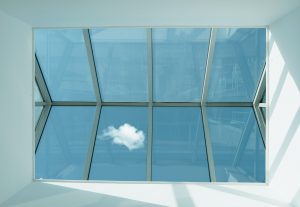
Adding natural lighting to your home has so many benefits. Natural light can lower your energy bill, make a room feel larger, provide an outstanding view of the night sky, and deliver sunlight that elevates your mood in the cold winter months.
Skylights and sun tunnels are two options for adding natural light beyond your windows.
But what’s the difference, and how do you know which to choose?
Skylights and Sun Tunnels
Skylights and sun tunnels are both installed through your roof to deliver natural light into your home. The main differences between the two are in size, placement, and appearance. Sun tunnels are more flexible if size and placement are an issue, while skylights add more to the aesthetics of your home with their unfiltered light and an unparalleled view of the sky.
What is a skylight?
A skylight is a type of window attached directly to your roof. It provides natural light directly into your home and gives you a view of the outdoors. Some skylights can be opened, allowing fresh air in as well as light. The natural light provided by skylights can make smaller rooms feel more spacious.
There are basically two types of skylights. A fixed skylight is sealed shut and doesn’t open. A vented skylight can be opened to let fresh air in.
There are also two types of skylight installation. A curb-mounted skylight is installed onto a separate, field-made frame that holds it higher than the roof face. Deck-mounted skylights come with the frame already attached as a part of the skylight.
What is a sun tunnel?
A sun tunnel delivers natural light into your home but doesn’t act as a window. It takes up less space than a skylight and can add natural light to areas where skylights aren’t an option. People love the effects of a sun tunnel in places like closets and hallways, although we’ve installed them in kitchen and living rooms as well!
Using a special acrylic dome, a sun tunnel captures light, magnifies it, and directs it down a tunnel and into your home through a light diffuser. A sun tunnel provides natural light but does not give you a view of the outside or allow fresh air in.
There are two types of sun tunnels. A flexible tunnel can be installed if there are obstructions to work around, while a rigid tunnel is installed when the hole through the roof to the ceiling is straight.
Skylight or Sun Tunnel – Which Works Best for Your Home?
Skylights and sun tunnels both deliver natural light directly into your home, so how do you determine which is your best fit? Each has its pros and cons. Refer to our article on skylight replacement and installation to get more tips on what to expect with a skylight.
Budget and installation time
If budget or speed of installation is your main concern, a sun tunnel is your best choice. The materials needed for a sun tunnel are only slightly lower than for a skylight, but the installation cost is significantly lower.
A sun tunnel may only take a few hours and one or two people to install. It involves cutting the hole, fitting the tube, then installing the dome on the roof and the light diffuser in the house.
A skylight takes more steps, requires more construction, and can take as long as a week to install depending on size and complexity. It requires cutting drywall, constructing the framing, installing the skylight, installing new drywall, weatherproofing the skylight with flashing, and painting.
Amount of light
Although a skylight and a sun tunnel both deliver natural light to your home, a skylight provides more. Before the light from a sun tunnel reaches your home, it has to go through the acrylic dome on the roof that captures and magnifies it and then the diffuser at the end of the tunnel in your home. A skylight, however, is a window that lets light shine directly into your home without diffusing it.
Design
Skylights come in many styles. They can be flat, domed, pyramid shaped, or vaulted. The window can have tinting or glazing, UV protection, motorized blinds or solar shades. Some open, some don’t. Read my article on “8 Things to Know before Installing Skylights” to make sure you understand the options available to you.
A sun tunnel doesn’t have many style options. It can be installed with a dimmer or shade, customized diffuser, nightlight, or a low-profile tunnel to maintain a flat roof face.
Energy efficiency
Sun tunnels provide energy efficiency by reducing your dependency on electric lighting. For overall energy efficiency, however, a skylight is your choice. The warmth and light they provide can decrease your energy costs, especially when installed with solar blinds.
Location
A sun tunnel is your most flexible option if space is an issue. Skylights have a much larger footprint and must be installed directly above the area needing light. On the other hand, a sun tunnel has a smaller footprint overall and can fit smaller spaces like hallways or closets that don’t usually get natural light. They can also be installed with a flexible tube that bends around obstacles. They can even extend through multiple floors, but the cost then increases significantly.
Let the Sun Shine In!
Skylights and sun tunnels both add value to your home by decreasing energy costs and increasing healthy, natural light. If you’re ready to let the sun shine into your home, call the professionals at Joyland Roofing for a consultation. We’ll help you design the best solution for your home and lighting needs. Give Joyland Roofing a call or fill out a contact form for your custom consultation!
Pennsylvania Home Improvement Contractor License (HIC) # PA124258

